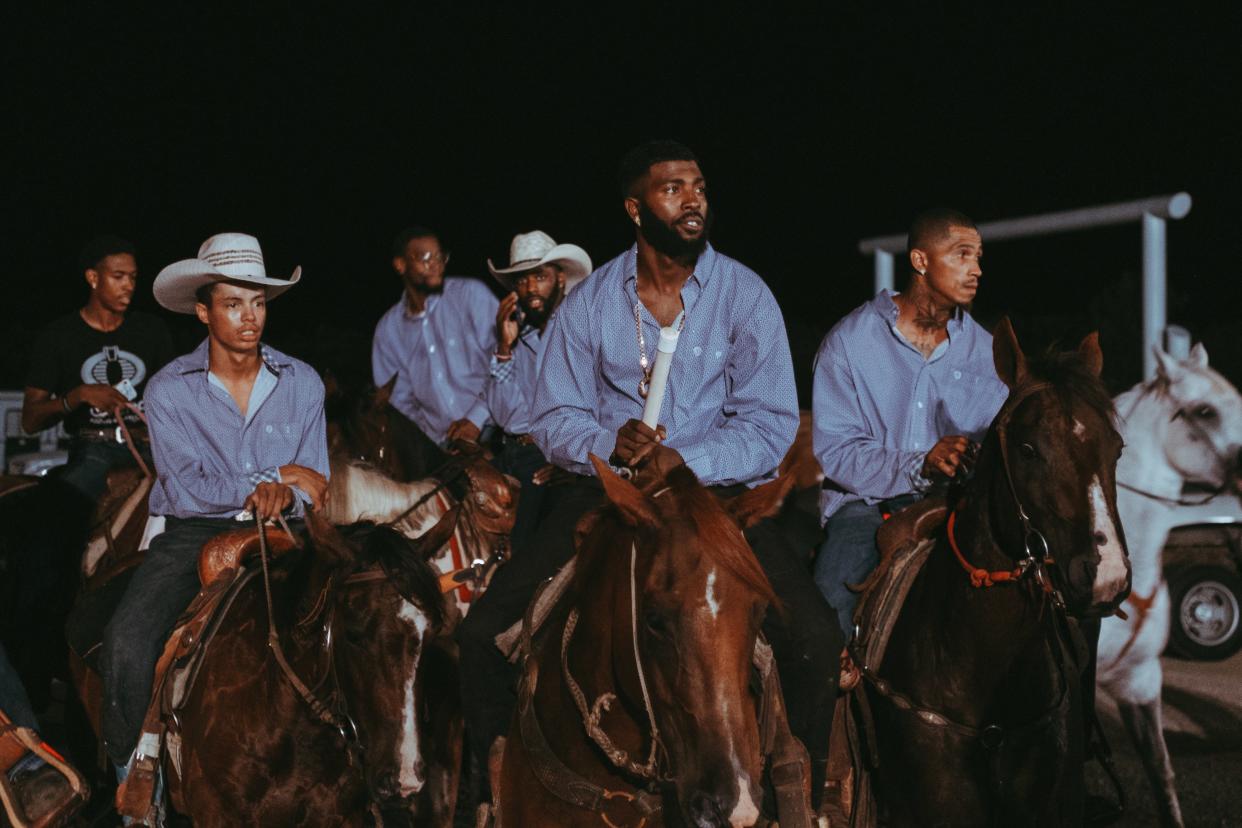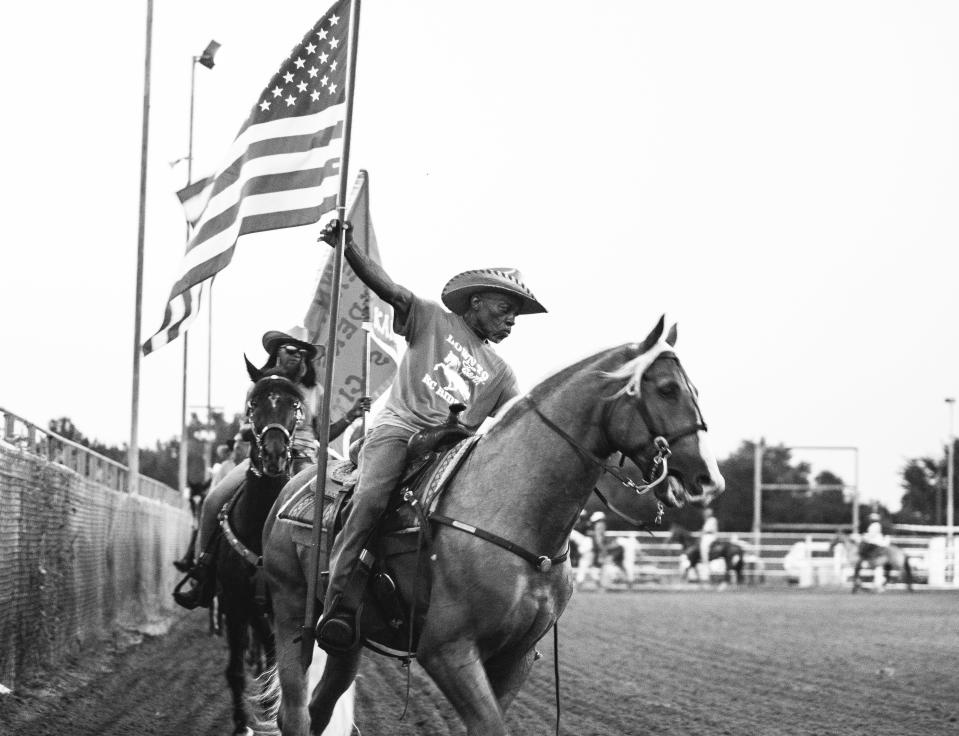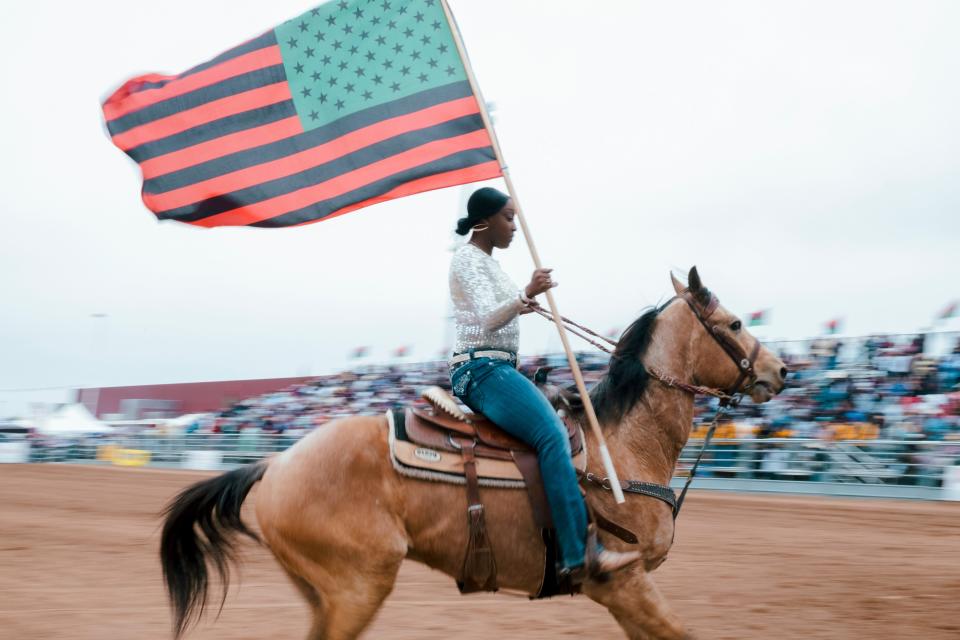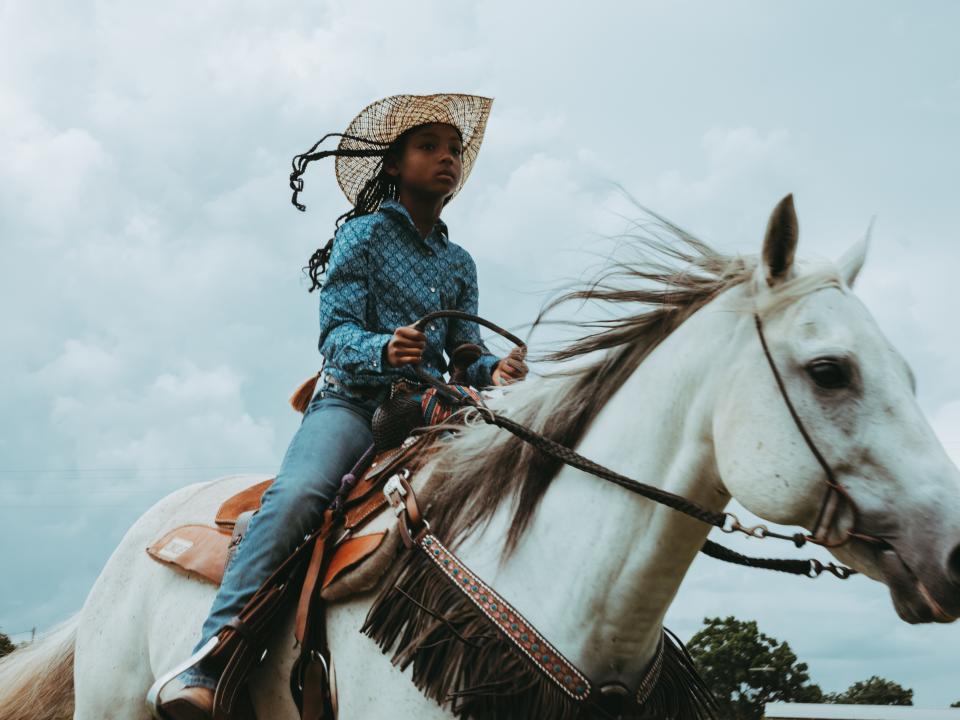A New Photo Book Celebrates the Style and Athleticism of America's Black Cowboys

- Oops!Something went wrong.Please try again later.
- Oops!Something went wrong.Please try again later.
- Oops!Something went wrong.Please try again later.
Ivan McClellan/Courtesy Damiani Books
Even though he grew up riding horses in Kansas City, photographer Ivan McClellan never identified with cowboy culture. That changed in the summer of 2015, when McClellan attended his first Black rodeo in Oklahoma, an experience he’s compared to stepping into his own Technicolor Oz. McClellan (who’s based in Portland, Oregon) spent the next few years traveling around the country, meeting the people who would later be featured in his new photo book Eight Seconds: Black Rodeo Culture, which Damiani Books will publish on April 30.
Eight seconds refers to the amount of time a rider must stay on a bull to score points. It’s also the title of the Juneteenth rodeo McClellan founded last year, in remembrance of his late friend, pro bull rider Ouncie Mitchell. “He did rodeo,” McClellan says, “and he was just sleeping in his car, trying to make ends meet, staying with people when he went to town. And he ended up getting murdered by one of the people he was staying with.”
The second 8 Seconds Juneteenth Rodeo will take place in Portland on June 16th; McClellan put up the $60,000 cash prize himself. “I set it as a goal to make it easier for other Black athletes to compete at the highest level of the sport,” he says. “So I thought I would infuse them with money and give them a platform.”
Zooming in from a gig in New York City, McClellan talked to GQ about his favorite Western fashion, risking horse-inflicted injury to get a shot, and the impact of Cowboy Carter.
The images in this book are stunning. How did you meet the people that you photographed?
Through doing street photography, I’ve just gotten good at walking up to strangers. I used to get super nervous and clam up, but just by doing the reps, I got a lot more open and a lot more friendly with people. I just go to events and roll up on folks and start to ask them questions. I've gotten better at asking the right questions. Talking about their horse is a good entry for a lot of folks because that's what they want to talk about, that's what they're passionate about. And then generally, once I get a rapport with somebody and talk to them a few times, then they'll introduce me to somebody else, and I'll end up at a ranch somewhere, or I'll end up at another event.
Were there specific places that you went to where you were like, I'm definitely going to find some interesting people to talk to here?
I can go anywhere and make it happen. My Super Bowl is in Okmulgee, Oklahoma. That was the first rodeo I went to, and I've been back time and time again, and there's always magic there. People are really open. And right around eight o'clock at night, the light gets very beautiful, and that's where I always have the best time shooting and meeting folks.
What was your idea of what a cowboy was like when you were younger? Did you watch Western films?
The first film that I really got into was Tombstone. My mom took us to see that in the theater. And it had Val Kilmer in it, Doc Holliday, Wyatt Earp, and all of these historical figures. I just really fell in love with that film—even though there weren't any Black people in it, I still just thought it was incredible, and probably where the sort of typical Western imagery got locked in for me. We would watch Gunsmoke and Bonanza reruns on TV, and I'd watch the Beverly Hillbillies, but Tombstone was the thing that connected with me the most.
In the foreword, Charles Sampson mentions that being a cowboy means working hard and living by a set of principles. What set of principles do you think define cowboy culture?
Just doing what you say you're going to do is a big one. I think so many folks in the city, they're like, "Yeah, let's meet up. Let's grab lunch," and then they never actually do it. Cowboys, if they say they're going to do something, they do it. And just being honest, being a friend to people until they prove that they're not worthy of your friendship.
In the book you write that fashion has become your favorite part of cowboy culture. What is one piece of clothing or style that you've adopted from cowboy culture?
One thing I'm trying to get right is creasing my jeans. Cowboys always have really hard creases in their jeans. They soak them in starch in the bathtub, and then they iron them, and they can stand up all on their own when they take them off. That's one piece I haven't quite gotten right, but that I aspire to. Putting on a cowboy hat is something I really wasn't comfortable with for years, but that I've adopted recently and wear with pride.
In the book, there are some photos of rodeo participants flying the American flag and variations of the African-American Flag and Pan-African flags. I'm sure you're familiar with the controversy surrounding the cover of Beyonce's Cowboy Carter, where she's holding the American flag. Some people were disappointed to see that, because she’s not holding a Black American flag. Was it a conscious choice to show your subjects holding many different types of flags, or did they just happen to be holding them?
I'm proud of both of those flags. I think they both represent parts of who I am. And I think the cowboys relate to their Black identity as much as they relate to their American identity. There's no preference, there's no hierarchy in these icons. It's just like, "I'm proud to be an American, I'm proud to be Black," and you wave [those flags] equally at these events. When the national anthem is played, everybody's got their hat off. And when prayers are prayed, everybody's got their head bowed. In this culture, there's no controversy around those symbols.


flag1
Ivan McClellanDo you listen to country music?
I started listening to it more seriously when I got into this, but as a kid, we would listen to Randy Travis. We would listen to Reba McEntire. Growing up in Kansas, it wasn't a big deal to listen to a little bit of country. It was when I got older that people were like, "Oh, country is not what you should be listening to as a Black man.” I stopped, but I’ve revisited it in the last six or seven years, just because I was riding around with Black cowboys and they were listening to Clint Black, and they were singing the lyrics. And I was like, "Oh, okay. I can enjoy this. This is cool." I listen to a lot of country music [now.] I just got Kacey Musgraves's new album on vinyl.
What are your thoughts on Beyonce's new album, Cowboy Carter, and the visibility that it's given to cowboy culture?
I think it's incredible. I think it's going to accelerate a lot of other folks in the country world. I was listening to the country music station in Portland the other day and they played it and I was just like, "That's a moment. That's an opening for a lot of people." I don't think I've ever heard of a Black woman on that radio station in the years that I've been listening to it. This is a sea change moment for Black folks that sing country music, and I think it's going to transform a lot of things.
What is one aspect of cowboy culture that you think would surprise a lot of people, or one thing that really surprised you?
I think how powerful and athletic the female athletes are. It's something that kind of gets left out in a lot of people's western work. It can be really male-focused, but the female barrel racers and their relationships with horses, and going 50 miles an hour sliding around barrels, is something that really, really blew my mind, seeing these powerful athletes with their long braids blowing behind them, and their hands clutching the reins with long acrylic nails. All of that imagery just was stunning to me, and it was just a part of the western world that I don't think has really been elevated yet.
What's your favorite photo in the book?
Oh, I don't know. I'll tell you the one that I was maybe most afraid to get is the picture of [cowgirl and barrel racer] Kortnee Solomon.

She's riding, basically, over the top of me on her horse. I'm on the ground, and she's looking really focused because I told her to ride right past me, and she's trying not to hit me. It's just a stunning photo, and I really like her. She's 11 in that photo, and she had the power and focus in her face—the clouds that are rolling in, and just the trust that I had that she wasn't going to run over me with that horse, created a really beautiful moment.
Originally Appeared on GQ

